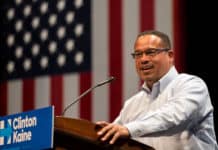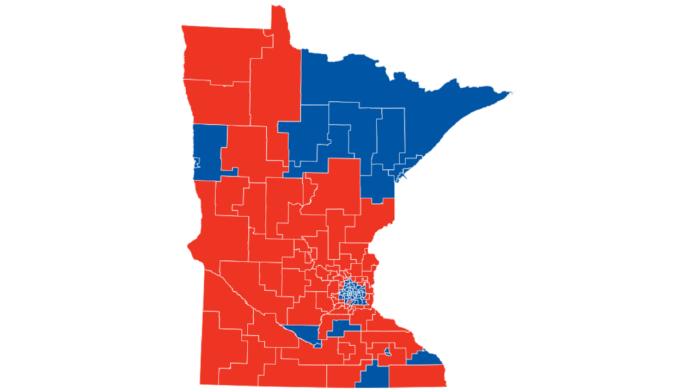The entirety of the Minnesota State Senate and House of Representatives is up for election on November 8. With 201 total legislative seats in play, Republicans only need to pick up six more Senate seats to gain control in that chamber, while the DFL only needs seven pick ups to take control of the House. Here are 12 Minnesota house districts to keep an eye on heading into Tuesday.
House District 4B – Rep. Paul Marquart (DFL) vs. Ben Grimsley (R)
Marquart is the only remaining DFL House member in a district that voted for Romney in 2012. Romney won 51-46, and the target on Marquart’s back is huge now, and spending for Grimsley is more than six-to-one. The Forum of Fargo-Moorhead has also emphatically rejected Marquart’s bid for reelection, emphasizing his rejection of flood control measures and lack of reduction of tax burden during his time in St. Paul.
House District 14A – Rep. Tama Theis (R) vs. Aric Putnam (DFL)
Theis won reelection 55-45 in 2014, but Romney only won a shade over 50 percent of the vote in 2012. The DFL has made this race a target in 2016, and money has been pouring in from both sides as a result. Putnam’s camp has a spending advantage of about $329,000 to Theis’ $214,000.
House District 14B – Rep. Jim Knoblach (R) vs. former Rep. Zachary Dorholt (DFL)
Knoblach has totalled seven non-consecutive terms in the House, first representing the area from 1995-2007. In 2014, he defeated Dorholt, then an incumbent running for reelection for the first time, by just 69 votes. Obama won this district 53-42 in 2012, and the St. Cloud State student population could turn the tide against Knoblach. Spending is large and fairly even in this race, with both camps having spent around $390,000 thus far.
House District 17B – Rep. Dave Baker (R) vs. former Rep. Mary Sawatzky (DFL)
In 2014, this was another case of a DFL representative losing their seat after one term. In 2016, it’s another case of that same politician trying to win their old seat back. Baker won 50.66 to 49.27 percent in 2014, and Sawatzky is hoping the higher turnout of a presidential election year will put her back in the House. Spending is even in this district as well, with both campaigns totalling around $270,000 each.
House District 21A – Barb Haley (R) vs. Lisa Bayley (DFL)
Incumbent Rep. Tim Kelly (R) is retiring from the legislature this year leaving the seat open. Kelly won reelection in 2014 by a 62-38 margin, but the district went 51-47 for Obama two years prior. Bayley is an eight-year member of the Red Wing city council, but Republicans have a spending advantage of over $100,000 in this campaign.
House District 28B – Rep. Gregory Davids (R) vs. Thomas Trehus (DFL)
Davids is a 12 term incumbent who won reelection in 2014 with 56 percent of the vote. He serves on the House Taxes Committee, while Trehus serves on a local school board. Obama won this district 52-46 in 2012 though. The DFL also has a two-to-one spending advantage here, in the third most expensive house race in Minnesota.
House District 44A – Rep. Sarah Anderson (R) vs. Ginny Klevorn (DFL)
Five-term incumbent Anderson won reelection with 56 percent of the vote in 2014, and Romney carried the district 51-48 in 2012. Klevorn’s camp, though, has outspent Anderson by about $70,000.
House District 48A – Laurie Pryor (DFL) vs. Mary Shapiro (R)
Rep. Yvonne Selcer (DFL) won reelection in 2014 by just 41 votes, and in 2012 by about one percent as well. With her retirement, that leaves this highly competitive district without an incumbent advantage. Shapiro is a former Minneapolis school teacher, while Pryor is a longtime DFL activist. Spending is relatively even, at about $258,000 for Pryor, and $236,000 for Shapiro.
House District 49B – Rep. Paul Rosenthal (DFL) vs. Max Rymer (R)
This district leans DFL, but not excessively so to put a tight election day out of reach. Incumbent Rosenthal has served three non-consecutive terms since 2008, being ousted by former Rep. Pat Mazorol in the 2010 election, before returning for two more terms. Most recently, Rosenthal defeated Barb Sutter 53-47. In 2012, the district went 52-46 for Obama. Rymer’s camp has a more than 2.5 to one spending advantage in this race which ranks as the 28th most expensive in the state in 2016.
House District 50B – Rep. Chad Anderson (R) vs. Andrew Carlson (DFL)
Former Rep. Ann Lenczewski resigned in December 2015 after winning reelection in 2014 with 66 percent of the vote. Anderson won the special election to replace her this past February 51-49 against Carlson. Carlson is a member of the Bloomington City Council, and the DFL has chalked up his loss to low turnout in the special election. Obama won the district 57-41 in 2012. Republicans have a nearly two-to-one advantage in spending here.
House District 56B – Rep. Roz Peterson (R) vs. Lindsey Port (DFL)
Peterson is up for reelection for the first time, having won her first term in 2014 with 54 percent of the vote. Her opponent is small business owner Lindsey Port. This was a very close district in the 2012 Presidential election, with Obama taking 49.07 percent to Romney’s 48.78 percent. Peterson’s camp has about a $126,000 spending advantage in the second most expensive House race this year.
House District 57A – Ali Jimenez-Hopper (R) vs. Erin Maye Quade (DFL)
Four-term incumbent Rep. Tara Mack (R) is retiring leaving the district more open for a DFL pickup. Jimenez-Hopper was born and raised in the district, while Maye Quade is a staffer for Congressman Keith Ellison (DFL-CD5) and recently moved into the district. Both candidates have drawn quite a bit of criticism. Jimenez-Hopper has been bashed for her view that Maye Quade is using her ethnicity and sexual orientation to play identity politics. Maye Quade drew some fire for her Twitter activity including references to day drinking and sex toy usage, as well as remaining on Ellison’s payroll while campaigning. Maye Quade has an almost $124,000 spending advantage in this race, the 10th most expensive in the state.


















